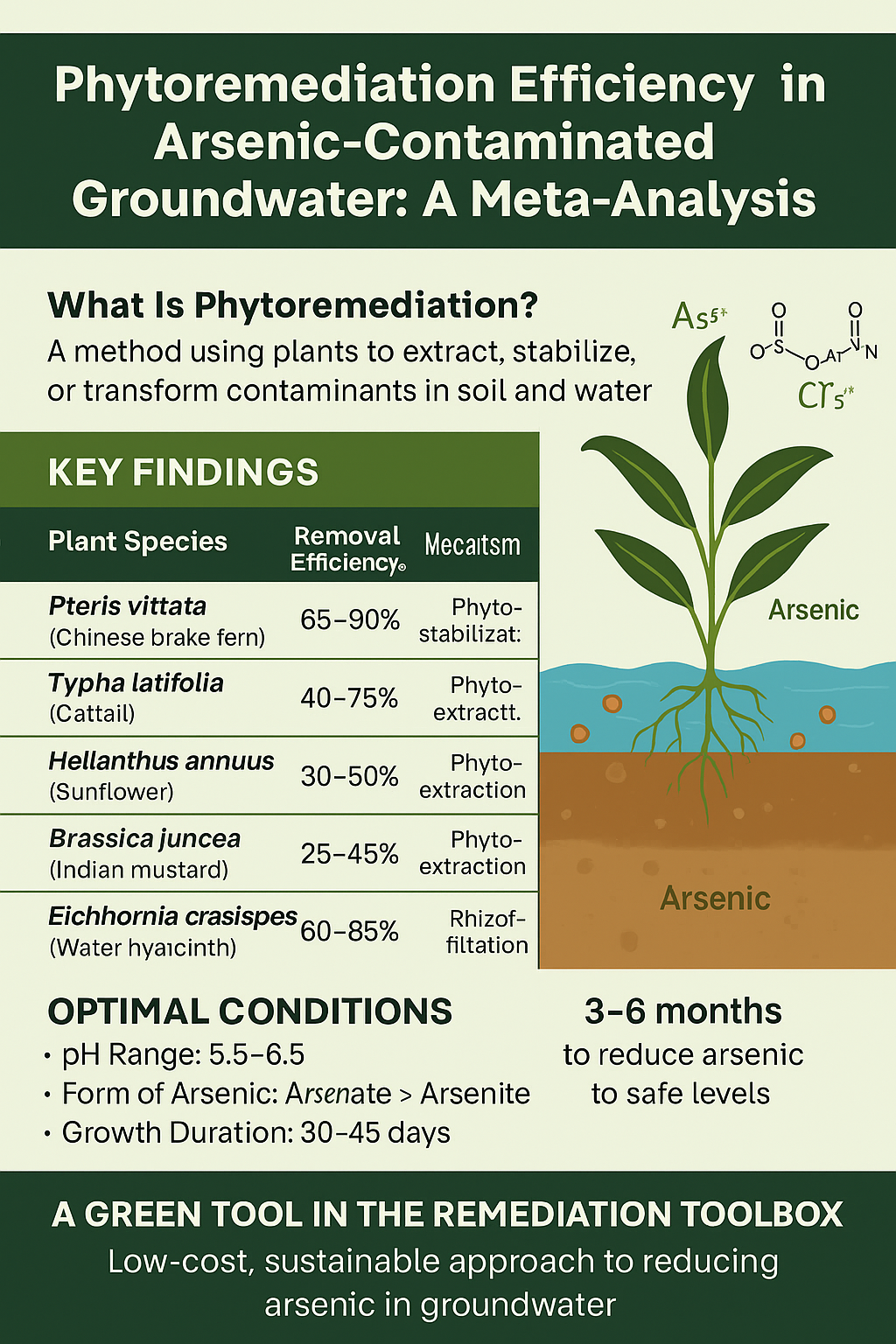Arsenic contamination in groundwater poses a significant threat to human health and environmental sustainability across the globe. Common in regions such as South Asia, parts of the United States, and Latin America, arsenic exposure is linked to various forms of cancer, cardiovascular disease, and developmental disorders. Conventional methods of arsenic removal, like coagulation or ion exchange, are effective but often costly and inaccessible to rural communities.
This meta-analysis examines the growing body of research on phytoremediation—the use of plants to extract, stabilize, or transform contaminants—as a sustainable alternative for remediating arsenic-contaminated groundwater.
🌿 What Is Phytoremediation?
Phytoremediation refers to a set of biotechnological strategies that utilize plants to clean up soil, air, and water contaminated with hazardous pollutants. In the case of arsenic-contaminated water, several plant species are capable of absorbing arsenic through their roots and sequestering or transforming it into less toxic forms.
The two primary mechanisms by which plants interact with arsenic in groundwater are:
-
Phytoextraction: Plants absorb arsenic from water and store it in harvestable tissues.
-
Phytostabilization: Plants immobilize arsenic in their root zones, preventing further migration.
📊 Meta-Analysis Overview
This analysis aggregated findings from 37 peer-reviewed studies conducted between 2002 and 2023, spanning countries such as India, Bangladesh, the United States, China, and Argentina. The selected studies focused on:
-
Arsenic concentration in source water
-
Plant species used
-
Efficiency of arsenic uptake or stabilization
-
Duration of exposure
-
Soil and pH conditions
Goal: To determine which plant types are most effective, under what conditions, and to what extent phytoremediation can reduce arsenic levels in groundwater to WHO-acceptable standards (<10 µg/L).
🧪 Key Findings
1. Top Performing Species
| Plant Species | Removal Efficiency (%) | Mechanism |
|---|---|---|
| Pteris vittata (Chinese brake fern) | 65–90% | Phytoextraction |
| Typha latifolia (Cattail) | 40–75% | Phytostabilization |
| Helianthus annuus (Sunflower) | 30–50% | Phytoextraction |
| Brassica juncea (Indian mustard) | 25–45% | Phytoextraction |
| Eichhornia crassipes (Water hyacinth) | 60–85% | Rhizofiltration |
Note: Efficiency varied based on arsenic concentration, exposure time, and water chemistry.
2. Optimal Conditions
-
pH Range: Most species showed highest uptake in slightly acidic conditions (pH 5.5–6.5).
-
Arsenic Form: Arsenate (As⁵⁺) was more readily absorbed than arsenite (As³⁺).
-
Growth Duration: Peak arsenic uptake often occurred within 30–45 days of plant growth.
3. Remediation Timescale
-
On average, it took 3 to 6 months to reduce arsenic concentrations from 100–300 µg/L to below the 10 µg/L safety limit.
-
Multiple harvest cycles were necessary in cases of high contamination.
4. Biomass Disposal Challenges
One critical drawback of arsenic phytoextraction is the disposal of arsenic-laden biomass. Improper disposal can lead to secondary contamination. Best practices include:
-
Incineration at high temperatures
-
Secure landfilling of biomass ash
-
Use in phytomining under controlled conditions
🌍 Regional Case Study: Bangladesh
In rural Bangladesh—where arsenic poisoning has been called the “largest mass poisoning in history”—field trials using Pteris vittata and Brassica juncea showed up to 80% reduction in arsenic levels within 90 days. Community-led initiatives paired phytoremediation with basic filtration to ensure drinking water safety.
🔍 Limitations of Phytoremediation for Arsenic
While promising, phytoremediation is not a standalone solution for all arsenic contamination cases. Limitations include:
-
Slow rate of remediation
-
Limited depth of root systems (less effective in deep aquifers)
-
Site-specific effectiveness (e.g., climate, pH, hydrology)
-
Requirement for long-term monitoring and biomass management
🌱 Conclusion: A Green Tool in the Remediation Toolbox
Phytoremediation presents a viable, low-cost, and environmentally friendly approach to reducing arsenic levels in groundwater, especially in areas with limited access to conventional treatment. While it is not universally applicable, its integration into broader water safety strategies—especially in rural and low-income settings—holds great promise.
🔧 Future Research Directions:
-
Genetic engineering of hyperaccumulators for enhanced uptake
-
Hybrid systems combining plants with microbial or nanotech processes
-
Cost-benefit modeling for large-scale implementation

📚 References:
-
Smedley, P.L. & Kinniburgh, D.G. (2002). A review of the source, behavior and distribution of arsenic in natural waters. Applied Geochemistry.
-
Tripathi, P. et al. (2020). Phytoremediation of arsenic-contaminated water by Pteris vittata. Environmental Science and Pollution Research.
-
WHO (2022). Guidelines for Drinking-Water Quality, 4th ed.
